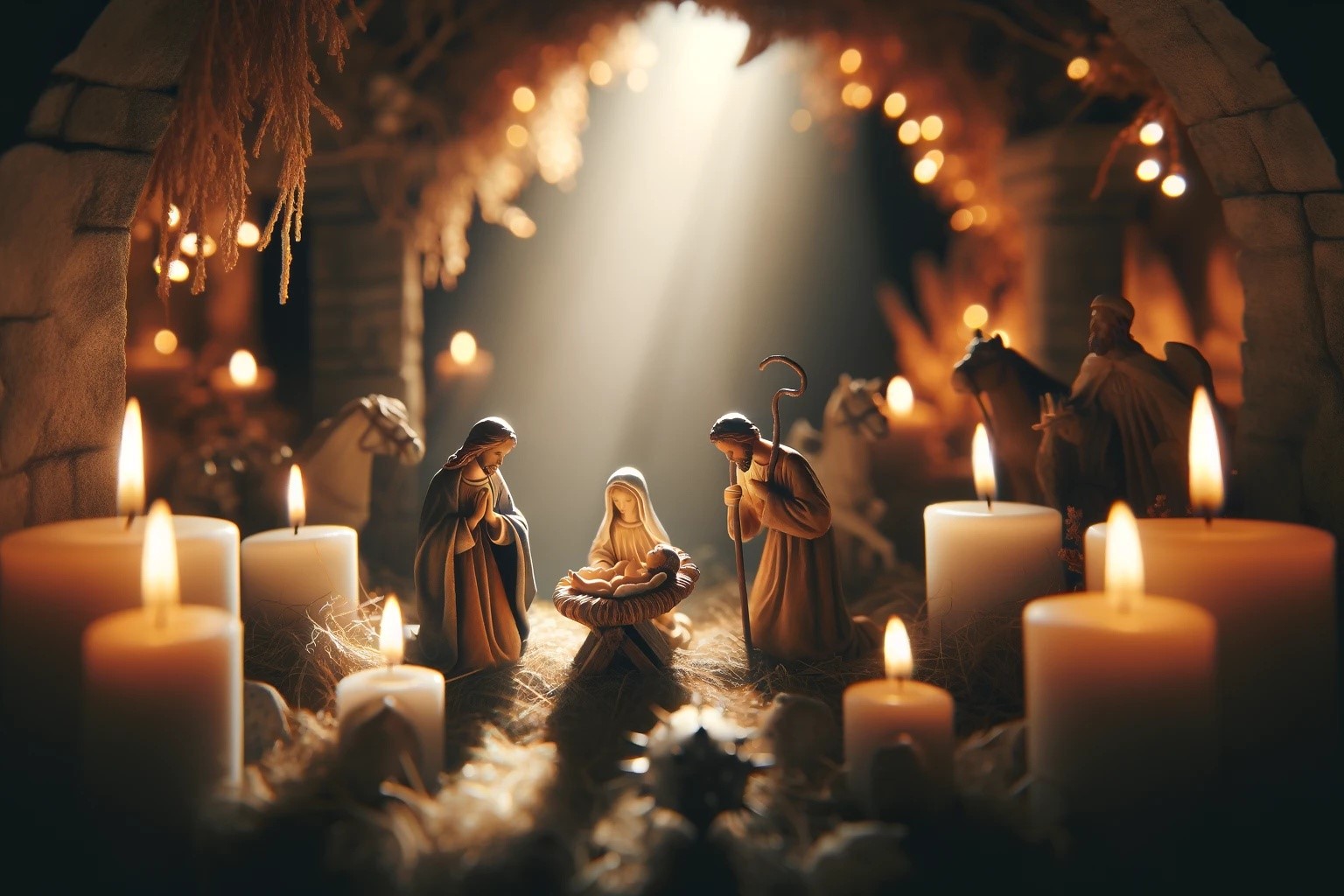Home>Special Themes>What Is The Second Advent


Special Themes
What Is The Second Advent
Published: February 14, 2024
Peter Smith, Editorial Director at Christian.net, combines deep insights into faith, politics, and culture to lead content creation that resonates widely. Awarded for his contributions to religious discourse, he previously headed a major organization for religious communicators, enhancing dialogue on faith's societal impacts.
Discover the significance and meaning of the Second Advent in this special-themed exploration. Uncover the theological and historical context of this pivotal event.
(Many of the links in this article redirect to a specific reviewed product. Your purchase of these products through affiliate links helps to generate commission for Christian.net, at no extra cost. Learn more)
Table of Contents
Introduction
The Second Advent, also known as the Second Coming of Christ, holds profound significance in Christian theology and eschatology. It is a concept that has sparked theological discussions, scriptural interpretations, and fervent anticipation among believers for centuries. The anticipation of the Second Advent is rooted in the teachings of Jesus Christ and the writings of the New Testament, particularly in the Gospels and the Book of Revelation.
The Second Advent is a central pillar of Christian faith, representing the belief in the return of Jesus Christ to fulfill the final stages of God's plan for humanity. This event is anticipated as the culmination of history, where Christ will return in glory, judge the living and the dead, and establish the long-awaited Kingdom of God on earth. The anticipation of this momentous event has been a source of hope, inspiration, and spiritual vigilance for Christians throughout the ages.
The concept of the Second Advent is not confined to a specific denomination or theological tradition but resonates across various branches of Christianity. It serves as a unifying belief that transcends denominational boundaries and theological differences, emphasizing the shared hope in the ultimate triumph of Christ and the fulfillment of God's redemptive purposes.
As we delve into the multifaceted aspects of the Second Advent, it is essential to approach this topic with reverence, scholarly inquiry, and a deep appreciation for its profound impact on Christian faith and practice. From exploring the theological underpinnings to examining the signs and prophecies associated with the Second Advent, this article aims to provide a comprehensive understanding of this pivotal doctrine and its implications for believers across different Christian traditions.
Read more: What Is The Second Candle Of Advent
Definition of the Second Advent
The Second Advent, also referred to as the Second Coming of Christ, encapsulates the belief in the return of Jesus Christ to earth in fulfillment of biblical prophecies and divine promises. This momentous event is deeply rooted in Christian eschatology and holds profound significance as the culmination of God's redemptive plan for humanity. The concept of the Second Advent is intricately woven into the fabric of Christian faith, serving as a focal point of hope, anticipation, and spiritual vigilance for believers across denominational lines.
At its core, the Second Advent embodies the conviction that Jesus Christ, who ascended to heaven after his resurrection, will return to earth in glory and power. This return is not merely symbolic or allegorical but is anticipated as a literal and transformative event that will usher in the final stages of God's divine purposes. The Second Advent is intricately linked to the biblical narrative of redemption, reflecting the promise of Christ's ultimate triumph over sin, death, and all forms of evil.
Central to the definition of the Second Advent is the belief in the dual nature of Christ's return. It encompasses the notions of judgment and restoration, wherein Christ is expected to judge the living and the dead, separating the righteous from the unrighteous, and establishing the eternal Kingdom of God. This duality underscores the theological complexity of the Second Advent, encompassing both the awe-inspiring majesty of Christ's divine authority and the compassionate fulfillment of God's redemptive love.
The Second Advent is not confined to a singular interpretation but encompasses a spectrum of theological perspectives and doctrinal emphases within Christian traditions. While the precise details and timing of this event have been the subject of scholarly debate and speculative inquiry, the overarching consensus revolves around the certainty of Christ's return and the transformative impact it will have on the course of human history.
In essence, the definition of the Second Advent encapsulates the profound hope, anticipation, and theological significance attached to the return of Jesus Christ. It serves as a beacon of assurance for believers, affirming the ultimate victory of Christ and the consummation of God's redemptive plan for creation. This foundational belief continues to inspire and unite Christians across diverse denominations, underscoring the enduring relevance of the Second Advent in shaping Christian faith and eschatological expectations.
Theological Perspectives on the Second Advent
The theological perspectives on the Second Advent encompass a diverse array of interpretations and doctrinal emphases within Christian theology. These perspectives reflect the multifaceted nature of eschatological discourse and the varying theological frameworks employed by different Christian traditions to understand and articulate the significance of Christ's return. While the core belief in the Second Advent remains a unifying tenet, the theological nuances surrounding this event have given rise to a rich tapestry of interpretations and doctrinal emphases.
One prominent theological perspective on the Second Advent revolves around the concept of inaugurated eschatology, which emphasizes the "already but not yet" tension in the fulfillment of God's redemptive purposes. This perspective underscores the belief that the Kingdom of God has been inaugurated through the life, death, and resurrection of Jesus Christ, yet awaits its consummation at the time of Christ's return. It highlights the tension between the present age and the age to come, shaping the ethical and eschatological outlook of believers as they anticipate the fulfillment of God's ultimate purposes.
Another theological perspective centers on the apocalyptic imagery and prophetic symbolism associated with the Second Advent, drawing from the vivid depictions found in the Book of Revelation and other prophetic passages in the Bible. This perspective underscores the cataclysmic and transformative nature of Christ's return, portraying it as a cosmic event that heralds the defeat of evil, the vindication of the righteous, and the establishment of God's eternal reign. It engenders a sense of awe, anticipation, and spiritual preparedness among believers, emphasizing the need for vigilance and fidelity in light of the imminent return of Christ.
Furthermore, various theological traditions offer distinct emphases on the eschatological implications of the Second Advent, ranging from preterist, historicist, futurist, and idealist interpretations of prophetic passages. These perspectives shape the understanding of historical events, the unfolding of divine purposes, and the ultimate destiny of humanity within the broader framework of eschatological thought. They contribute to a rich tapestry of theological reflection, inviting believers to engage with the profound mysteries of God's redemptive plan and the ultimate consummation of all things in Christ.
In essence, the theological perspectives on the Second Advent reflect the depth and diversity of Christian eschatology, encompassing a spectrum of interpretations, emphases, and doctrinal frameworks that enrich the understanding of Christ's return. While these perspectives may vary in their theological nuances, they collectively affirm the central hope in the triumphant return of Jesus Christ and the fulfillment of God's redemptive purposes, underscoring the enduring significance of the Second Advent in shaping Christian faith and eschatological expectations.
Signs and Prophecies of the Second Advent
The signs and prophecies of the Second Advent hold a central position in Christian eschatology, serving as focal points of anticipation, reflection, and spiritual discernment for believers. Throughout the New Testament, particularly in the teachings of Jesus and the writings of the apostles, numerous signs and prophecies are presented as indicators of the imminent return of Christ. These signs, often intertwined with apocalyptic imagery and prophetic symbolism, offer a framework for believers to discern the unfolding of God's redemptive plan and to cultivate a posture of readiness and spiritual vigilance.
One of the prominent signs emphasized in the New Testament is the prevalence of global upheaval, including wars, famines, earthquakes, and natural disasters. These tumultuous events are depicted as precursors to the culmination of history, signaling the approaching return of Christ. The Gospel of Matthew records Jesus' words regarding these signs, underscoring their significance in heralding the end times and the imminent manifestation of Christ's glory.
Additionally, the proliferation of false prophets and the rise of deception are highlighted as indicators of the last days. The apostle Paul, in his letters to the early Christian communities, warned about the emergence of false teachings and deceptive doctrines that would seek to lead believers astray. This prophetic insight underscores the need for discernment and doctrinal fidelity as believers navigate the complexities of the present age in anticipation of Christ's return.
Moreover, the New Testament scriptures underscore the restoration of Israel and the ingathering of the Jewish people as a pivotal sign of the end times. The prophetic imagery surrounding the reestablishment of Israel as a nation and the regathering of the Jewish diaspora serves as a poignant fulfillment of biblical prophecies, signaling the unfolding of God's redemptive purposes and the approaching climax of history.
Furthermore, the escalation of global turmoil, moral decay, and societal unrest is depicted as a hallmark of the last days. The apostle Paul's description of the perilous times and the prevalence of ungodly behaviors resonates with the prophetic warnings concerning the moral and spiritual climate preceding the Second Advent.
In essence, the signs and prophecies of the Second Advent provide believers with a framework for understanding the unfolding of God's redemptive plan and the imminent return of Christ. While these signs are not intended to evoke fear or anxiety, they serve as reminders of the steadfast hope in Christ's ultimate triumph and the consummation of God's purposes. As believers engage with these prophetic indicators, they are called to cultivate a posture of spiritual readiness, discernment, and faithful anticipation, anchoring their hope in the promise of Christ's glorious return.
Importance of the Second Advent in Christianity
The Second Advent holds profound importance in Christianity, permeating the core of Christian faith, shaping eschatological expectations, and inspiring unwavering hope in the ultimate fulfillment of God's redemptive plan. At the heart of Christian belief lies the anticipation of Christ's return, which serves as a beacon of assurance, a catalyst for spiritual vigilance, and a source of profound hope for believers across diverse denominations and theological traditions.
The significance of the Second Advent is rooted in its portrayal as the culmination of history, where Christ will return in glory, judge the living and the dead, and establish the eternal Kingdom of God. This pivotal event embodies the assurance of Christ's ultimate triumph over sin, evil, and death, offering believers a profound sense of hope and assurance in the face of life's uncertainties and trials. The Second Advent serves as a powerful reminder of the ultimate victory of Christ and the consummation of God's redemptive purposes, instilling believers with a steadfast hope that transcends temporal challenges and adversities.
Furthermore, the importance of the Second Advent is intricately linked to the ethical and moral implications it holds for believers. The anticipation of Christ's return fosters a sense of spiritual vigilance, calling believers to live with integrity, faithfulness, and a steadfast commitment to the teachings of Christ. This eschatological outlook shapes the ethical framework of Christian living, inspiring believers to embody virtues of love, justice, compassion, and righteousness as they await the fulfillment of God's ultimate purposes in Christ.
Moreover, the Second Advent serves as a catalyst for eschatological reflection and theological inquiry within Christian communities. It engenders a deep sense of anticipation and contemplation regarding the ultimate destiny of humanity, the restoration of creation, and the establishment of God's eternal reign. This contemplative stance invites believers to engage with the profound mysteries of God's redemptive plan, fostering a deeper understanding of the transformative implications of Christ's return for the course of human history and the fulfillment of God's promises.
In essence, the importance of the Second Advent in Christianity extends far beyond a doctrinal belief; it permeates the fabric of Christian faith, inspiring hope, ethical fidelity, and eschatological reflection. This pivotal doctrine underscores the enduring significance of Christ's return as the ultimate fulfillment of God's redemptive purposes, offering believers a steadfast anchor of hope and assurance in the face of life's complexities and uncertainties. As Christians anticipate the Second Advent, they are called to embody a spirit of readiness, faithfulness, and unwavering hope, anchoring their lives in the transformative promise of Christ's glorious return.
Read more: What Is The Second Sunday Of Advent
The Second Advent in Different Christian Denominations
The belief in the Second Advent, or the Second Coming of Christ, resonates across various Christian denominations, each offering unique perspectives and doctrinal emphases on this pivotal eschatological event. While the core tenet of Christ's return remains a unifying belief, the nuances of interpretation and emphasis on the Second Advent vary among different denominational traditions, reflecting the rich diversity within the broader tapestry of Christian faith.
In evangelical and fundamentalist traditions, the Second Advent is often emphasized as a central doctrine, shaping the eschatological outlook and spiritual fervor of believers. These traditions place a strong emphasis on biblical prophecy, apocalyptic imagery, and the imminent return of Christ, fostering a sense of urgency in preparing for the anticipated culmination of history. The belief in the rapture, tribulation, and millennial reign of Christ holds significant prominence in these denominational perspectives, underscoring the transformative and cataclysmic nature of Christ's return.
Within the Catholic tradition, the Second Advent is intricately woven into the liturgical calendar and the sacramental life of the Church. The anticipation of Christ's return is expressed through the lens of hope, redemption, and the eschatological fulfillment of God's promises. The Catholic perspective on the Second Advent emphasizes the continuity of Christ's presence in the Eucharist and the eschatological consummation of God's Kingdom, fostering a sense of hopeful expectation and spiritual preparedness among believers.
In the Eastern Orthodox tradition, the Second Advent is viewed within the broader framework of theosis, or the transformative union with God. The emphasis on divinization and the eschatological fulfillment of humanity's union with God shapes the Orthodox understanding of Christ's return. The Second Advent is intricately linked to the restoration of all things in Christ, emphasizing the ultimate triumph of God's redemptive purposes and the transfiguration of creation in the divine presence.
In the Protestant Reformed tradition, the Second Advent is often viewed through the lens of covenant theology and the fulfillment of God's promises to His people. The emphasis on God's covenantal faithfulness and the eschatological consummation of redemption shapes the Reformed perspective on the Second Advent, fostering a sense of steadfast hope and assurance in the ultimate fulfillment of God's redemptive plan.
In summary, the Second Advent is a unifying belief that transcends denominational boundaries, yet it is expressed and emphasized in diverse ways within different Christian traditions. The multifaceted perspectives on the Second Advent reflect the richness of Christian theology and eschatological reflection, inviting believers to engage with the profound mysteries of Christ's return and the ultimate consummation of God's redemptive purposes.
Conclusion
The Second Advent, or the Second Coming of Christ, stands as a foundational doctrine that permeates the essence of Christian faith, shaping eschatological expectations, inspiring unwavering hope, and fostering a sense of spiritual vigilance among believers. Throughout the centuries, the anticipation of Christ's return has been a source of profound theological reflection, spiritual contemplation, and fervent expectation within Christian communities across diverse denominations and theological traditions.
As we conclude this exploration of the Second Advent, it becomes evident that this pivotal doctrine holds enduring significance in the tapestry of Christian faith. The belief in Christ's return serves as a beacon of assurance, anchoring believers in the steadfast hope of the ultimate fulfillment of God's redemptive plan. It engenders a sense of ethical fidelity, calling believers to embody virtues of love, justice, and righteousness as they anticipate the consummation of God's Kingdom.
Moreover, the signs and prophecies associated with the Second Advent serve as poignant reminders of the unfolding of God's redemptive purposes and the imminent return of Christ. While these signs are not intended to evoke fear or anxiety, they invite believers to cultivate a posture of spiritual readiness, discernment, and faithful anticipation, anchoring their hope in the promise of Christ's glorious return.
The theological perspectives on the Second Advent, ranging from inaugurated eschatology to apocalyptic imagery, reflect the depth and diversity of Christian eschatology, enriching the understanding of Christ's return and its transformative implications for the course of human history. These perspectives invite believers to engage with the profound mysteries of God's redemptive plan, fostering a deeper appreciation for the ultimate consummation of all things in Christ.
Furthermore, the Second Advent resonates across various Christian denominations, each offering unique insights and doctrinal emphases on this pivotal eschatological event. While the nuances of interpretation may vary, the belief in Christ's return unites believers in the shared hope of the ultimate triumph of Christ and the establishment of God's eternal reign.
In essence, the Second Advent stands as a testament to the enduring hope, assurance, and transformative promise embedded in Christian faith. As believers anticipate the glorious return of Christ, they are called to embody a spirit of readiness, faithfulness, and unwavering hope, anchoring their lives in the transformative promise of Christ's triumphant return.














